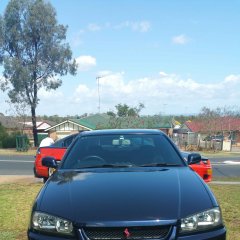Haltech Finds The Limit Of Their R35's Engine
Announcements
-
Similar Content
-
Latest Posts
-
I know this is a super old topic, but what ended up being the problem?
-
I know this is an old thread but I have a particular attachment to the ENR34, so I don't think additional content hurts. For starters, I agree with everyone here in that the performance of a stock R34 GTR is a pretty low bar and one that you're going to spend a lot of money "matching". Now if you're willing to deviate from that template as your goal, you'll be much better off and enjoy the car much more. The engine in the NA R34s is a real kick in the nuts in terms of upgradability compared to previous generation NA cars. The NA heads on the RB2X NEOs have MUCH smaller intake port cross sections and are not compatible with any of the aftermarket forward-facing manifolds available for the RB25DET. This can be remedied with a RB25DET NEO head, but those are expensive relative to what they are. A full long-block from a turbo AWD Stagea is generally a better value and will run you about $4000 USD to get it to you. This will get you the stronger RB26DETT rods, as well. That would give you a base to build off of to be safe in the 400whp range. Not shooting for the moon, but if the stock R34 was your bar, this engine would buy you enough to be just North of stock GTR power. A forward facing manifold would allow for the easiest method toward using Bosch EV14 format injectors such as those from Injector Dynamics and FIC, to name a couple. People hate them because they're copies, but Greddy fakes can be had for around $300 USD. With what the fuel rail, regulator, injectors, and the rail adds, figure $2000 USD for the whole setup including the manifold. With the OEM brackets and a bit of trimming to the ends of the lower frame rails, the OEM intercooler mounting brackets can be used to mount an OEM GTR intercooler, or an aftermarket one made for a GTR. Those are handy vs a universale due to the angles that the end tanks have on them. Then your plumbing become super straightforward at that point despite having to cut a hole where the battery is an a matching one on the other side for the pipes. Battery can go to the trunk. I'd round up to a healthy $2000 USD here too (maybe even a tiny more) to allow for a nice aftermarket unit and some pipe fabrication. Or if you can find someone that's upgrading to something larger, the used market comes in clutch here for a decent savings. I won't even get into turbo sizing as that's something that would be for yourself to determine. HOWEVER, for the purposes of your stated goals, a Borg Warner 7064 with an internal wastegate would be a perfect spooler and would make stock GTR power easily. It would also bolt up to your OEM manifold (that would come with the DET you purchased a couple steps above) if it were ordered with a T3 flange. More with adequate fuel. If you can stick with the OEM exhaust manifold then expect to be in the whole about $6000 USD for decent turbo like the one suggested, a down pipe, new O2, and full exhaust to mate up, and upgrades to the integrated BOV in an EFR or a standalone BOV for a different turbo, as well as an aftermarket IWG (internal waste gate). Those last two are definitely optional and unnecessary. All of this stuff above does you no good without any way of tuning and or monitoring the engine. Bite the bullet on a standalone engine management solution. If your experience with wiring is limited, you're going to have to hand it off to someone else, though. Unfortunately, the adapter/patch harnesses available are typically made around the GTT which does not include AWD, and the GTR, which integrates into a lot of chassis features that aren't present in your wiring interface. So the ENR34 is the oddball. So you'll want to expand a bit on your selection and find an ECU that's capable of running the ATTESA pump also. I have a Link Thunder, but you don't need quite that much ECU to accommodate that. You WILL need someone with the know-how to tune it and code those features into whatever software it uses. And to wire it up. This will be your most significant expense. Call it $6000 USD with an ECU, an okay wiring job (no motorsport grade at this price), aftermarket triggers and R35 coils, and the time it takes to tune the ECU with added features (electronic boost control solenoid, MAP, IAT, the new triggers, and ATTESA) and don't be surprised if it's more if you want better work done. Grab a clutch made for any RB pull transmission R32/R33GTR made for the power handling capacity you're looking for. Budget $1500 USD for a new good one. That's about $20,000 USD for an engine you've upgraded yourself and had wired and tuned by someone else. That's no brakes (ENR34 brakes are pathetic), suspension (again, pathetic), or wheels and tires. So you're pretty spot on in terms of spending $30,000 USD extra on the car just to get it to perform a little better than a stock R34 GTR while looking like a bone stock ENR34 with some wheels and suspension mods. That doesn't include fluids, maintenance items, gaskets/seals, repairs needed or anything else discovered along the way. But you'll have a car you can take to the track and have fun without worrying as much about nicks and dings.
-
Okay so, please read this. car started and ran fine. got my tuned ecu by RSenthalpy, did a bunch of pulls to test it out and finally drive the car after half a year of it just sitting and idling at most. Everything was good, thing ran flawlessly and had so much power, didn't feel slower than a Prius anymore. Parked it back and turned it off. Next day, I install an AFR and start the car. Didn't wire anything to the ecu. Just gauge. Car started, but died out in about a minute. I figured it was cause my car was on a lift and the fuel was really low and old. I add 5 gallons of fuel, still cranks but no start. I remove all AFR wiring (tapped into double din acc and power wires but there was a nest of wiring there so I was worried I messed something up. tried to put it back to how it was prior to afr install.) Still cranks no start. Changed spark plugs with brand new ones Changed fuel pump with a new one (verified working) Did compression test , compression came back all at 150ish. All fuses are good, Relay seemed good but ill double check by switching similar relays around. Verified MAF is working - Ended up getting curious as to why fuel pump is not priming when ignition is on, so I cut the fuel pump ground and power and connected them directly to a portable jumper. I also disconnected fuel line to fuel rail to verify fuel is being sent. So with direct jumper power, the fuel pump turns on and shot gas everywhere through the fuel pipe that I had disconnected, so ny doing that, I verified no clogs in fuel lines or filter. - Tried starting the car with that jumper directly wired to power and ground, but car still did not start. I'm guessing its a CAS issue but im a little scared to check it without messing up timing or anything else since I actually dont understand how to check CAS lol. If anyone has any other suggestions or recommendations , please let me know.
-
Hi all. I am aware there is lots of discussions about jacking points, where to lift the car and what not. But as usual just a lot of "in my opinion" and nothing definitive, and everyone does it in a different way. I want to hear from some experienced people on which points on the car it's okay/safe/recommended to lift the car using a four point hoist/lift. I will attach some images of my underbody. Sills are largely okayish, the driver side jacking point is pretty mangled though and it looks like the underfloor is slightly pushed in too, but I might be wrong. In the German Skyline forum, the consensus is to use the sidemember chassis rails in the front and the rear subframe? bushing in the rear. I know the manual says to never use the sidemember for loading but lots of folk do it and it was definitely done on my car too as they are slightly bent too. Based on the images, what points do I use to not make the already present damage worse? I'd use wood or rubber blocks to spread the load across a bigger area of course. Driver side sidemember and jacking point mangled one) https://imgur.com/a/eKjzrJX Driver side rear jacking point https://imgur.com/a/W3DWF1P Passenger side sidemember and jacking point https://imgur.com/a/65UvIJe Passenger side rear jacking point https://imgur.com/a/h3k7j53 We can also see some underbody rust but so far it all looks somewhat treatable and nothing that requires a Yoshida style restoration.
-
Have you put an aftermarket oil pressure gauge on and verified your oil pressure? Noise being on the block, on exhaust side, how high up the block does it seem to be? It could be the VCT system getting cranky, especially if it's mainly at idle, and when warm, as that'll be your lowest point for oil pressure. Could be showing that oil passages / VCT solenoid are blocking.
-






Recommended Posts
Create an account or sign in to comment
You need to be a member in order to leave a comment
Create an account
Sign up for a new account in our community. It's easy!
Register a new accountSign in
Already have an account? Sign in here.
Sign In Now